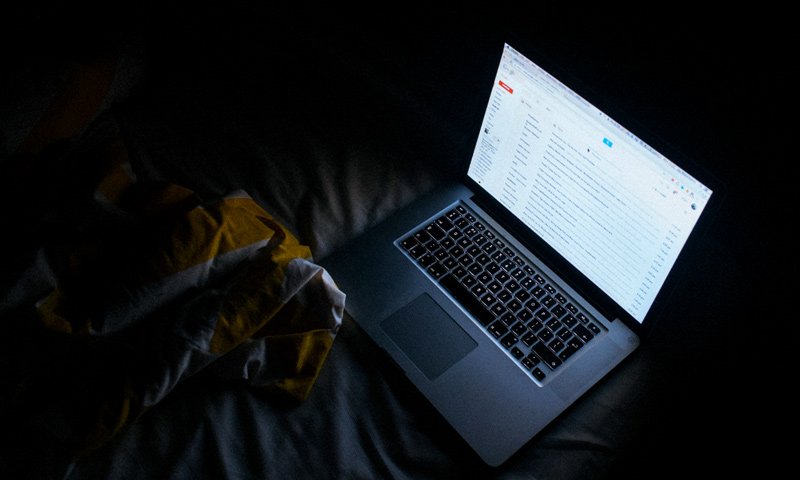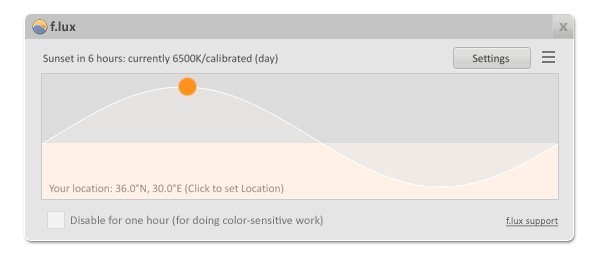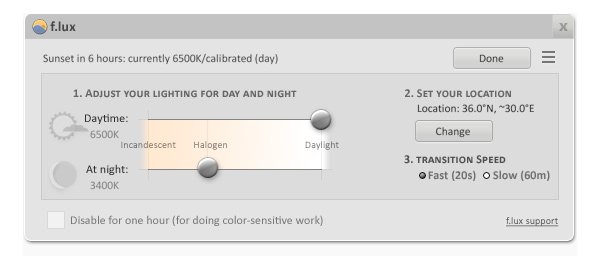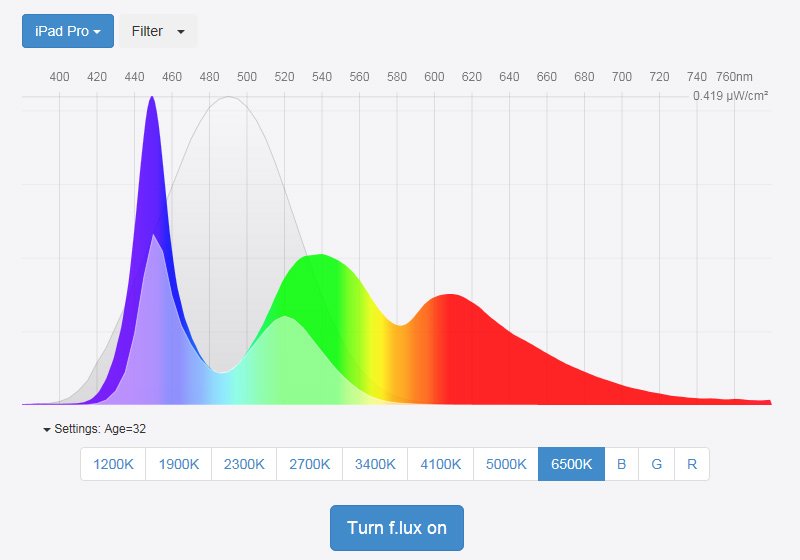
I'm continuing the topic about how to get better and easier sleep at night if you are using electronic devices such as smartphone, tablet, or a computer late at night before going to bed or even after you get. Not sure if you have checked my technical analysis of iOS Night Shift mode yet, but you might want to read it as well. Here my focus will not be iPhone and other iOS devices that already have a built-in function to reduce the Blue Light at night - the so called Night Shift mode. Instead it will be on how to achieve similar functionality with additional software on your Computer - PC or a MAC. I'll introduce you to a very useful and free to download and use program called f.lux that can do the same as the Night Shift mode on iOS, but do it for your computer. It is a very useful tool for everyone spending long hours on Steemit including posting and curating late at night as well...

What is f.lux
f.lux is a software that makes the color of your computer's display adapt to the time of day, warm at night and like sunlight during the day... essentially eliminating the problematic blue light when it gets dark. This should help late night users to get a better sleep after spending some hours during a night working or just browsing interesting stuff online.
Much like the Night Shift mode on iOS, using f.lux is very easy, you just need to do download it and run on your computer and it will start working out of the box with nothing normally required from the user. The only thing you may need to set is your location, so that the software will automatically switch on and off the night mode when the sun outside sets.
When the sun sets, the software changes the color temperature of your display to a warmer one. The standard value for computer displays is usually 6500K and that is what the software will try to use during the day (your default monitor settings won't be changed), but as soon as the sun sets it will move to 3400K color temperature that will make the image of the display warmer (more reddish). When the sun raises on the next day your computer display will be back to normal mode again. Alternatively you can Disable the software for one hour quickly and easily if you need to have color accuracy for doing some photo editing for example.

Setting Up f.lux
Even though in order to start using f.lux you don't have to do anything, there are some additional settings you can tweak if you want to customize a bit more the way the software works. You have the option to change the color temperature of the normal mode as well as the night time mode from the default values of 6500K and 3400K respectively. Changing your location if the software does not figure it out correctly as well as control the transition speeds between the day and night modes.
The default transition speed is set at 20 seconds and that change could be considered a bit rapid, but if you switch to the slow mode at 60 minutes it is going to be much smoother transition for the user. So I would advise to give both options a try and see if you may actually like the slower transition better, I know I do since use it that way. Also you might want to go for the 4200K mode instead of the warmer 3400K default mode, so give it a try as well if you don't like the too warmer image at the default color temperature 3400 Kelvin. There are some extra features and settings also available for more advanced users, but I'll let you explore this yourself...

More About the f.lux Software
One very interesting fact about that software is that it actually is much older than the quite recently introduced official Night Shift feature on iOS. Initially the f.lux software was made available for jailbroken iPhones, though now that there is official similar feature available for supported more recent Apple mobile devices it is not needed. You can still install the software on an older iPhone or other iOS device that does not come with official Night Shift support, but you will also need to jailbreak it first. One can even say that it is this software that has inspired Apple to work on a similar official feature that became known as Night Shift in the iOS 9.3 update.
Owners of Android-based spamrtphones and tablets may also give f.lux for Android a try, there is a preview version posted on Google Play that however requires rooted device in order to be used (similar to the need of a Jailbroken iOS device). According to the developer most rooted Lollipop and Marshmallow devices (Android 5.x and 6.x) should work with the program, while only some rooted Kitkat (Android 4.x) devices may work, so you need to try and see for yourself if your device uses older Android version.
The f.lux software is also available for computers, mobile and desktop, that use Windows, Linux or Mac OS. So essentially all major operating systems for computers and mobile devices are supported, though for mobile there are some specific requirements like a jailbroaken or rooted device as well as some OS version requirements. So my personal advice is to give f.lux a try and see if you like what it does and if it actually helps you or not to get to sleep faster at night and maybe getting a better sleep if you tend to use a computer late at night.
I have not yet done a detailed analysis of the changes that f.lux does with a spectrometer, like I did with the Night Shift mode on iOS, but I may do that later on in a separate post if there is interest in a more advanced test. Do note that unlike with an iPhone SE for example that uses only one type of display, with computers - desktop and laptops, there are many different displays and the results may vary a lot, so the best thing is to try on what you are using. There is an interesting online tool called fluxometer that can get you a real-time simulation on how the f.lux software can affect the image displayed with different settings for color temperatures on different devices. So you might want to give that one a try as well and do check the f.lux software.
If you have a question or want to add something, then please leave a comment below.
Did you like what you have just read? Check my other posts on steemit @cryptos
